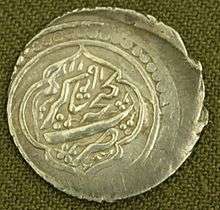Ganja Khanate
| Ganja Khanate | ||||||||||
| Khanate | ||||||||||
| ||||||||||
| Capital | Ganja | |||||||||
| Languages | Persian (official),[1] Azerbaijan | |||||||||
| Religion | Islam | |||||||||
| Government | Khanate | |||||||||
| History | ||||||||||
| • | Established | 1747 | ||||||||
| • | Disestablished | 1805 | ||||||||
| ||||||||||


The Ganja Khanate (Persian: خانات گنجه — Khānāt-e Ganjeh, Azerbaijani: Gəncə xanlığı, Ҝәнҹә ханлығы, گنجه خنليغى) was a semi-independent Caucasian khanate that was established in Afsharid Iran and existed in the territory of what is modern-day Azerbaijan between 1747-1805. The principality was ruled by the dynasty of Ziyadoglu (Ziyadkhanov) of Qajar extraction as governors under the Safavids[2] and Nadir Shah. Shahverdi Solṭan Ziyad-oglu Qajar became the khan of Ganja in 1554.[2]
Political history
In the latter part of the 18th century, the Ganja khanate was one of the most economically prosperous polities in the Caucasus, benefiting from the strategic location of its capital on the regional crossroads. For this reason, two politically stronger neighbors, the Kingdom of Georgia and the Karabakh khanate, encroached on the independence of Ganja.
From 1780 to 1783, the Ganja khanate was a condominium of Heraclius II of Georgia (represented by Prince Kaikhosro Andronikashvili) and Ibrahim-Khalil khan Javanshir of Karabakh (represented by the vizier, Hadrat Quli Beg). In 1783, Ganja rose up against its Georgian and Karabakh overlords. Georgians tried to reconquer Ganja at the end of 1784, but the campaign ended unsuccessfully. So did the Georgian invasions in 1785 and 1786. Under Javad Khan's rule from 1785 to 1804, the Ganja khanate grew in economic and political importance. The khans had their own mint in Ganja.
Around the same time, a new strong central authority had been established in mainland Iran by Agha Mohammad Khan. The Ganjavis actively welcomed the new Iranian ruler; not only in the hope for receiving protection, but also for gains at Georgia's expense to make up for the losses suffered in the 1780s.[3]
In 1795, Javad Khan of Ganja joined the Iranian expedition against Georgia.[3][4]
Russian conquest
During the first Russo-Persian War (1804-1813) Ganja was considered by Russians, who had earlier supported Georgian claim to the sovereignty over the khanate, as a town of foremost importance. General Pavel Tsitsianov several times approached Javad khan asking him to submit to Russian rule, but each time was refused. On November 20, 1803, the Russian army moved from Tiflis and in December, Tsitsianov started the siege preparations. After heavy artillery bombardment, on January 3, 1804 at 5 o'clock in the morning, Tsitsianov gave the order to attack the fortress. After fierce fighting the Russians were able to capture the fortress. Javad khan was killed, together with his sons. According to a major study of the military events in the Caucasus by John F. Baddeley:
| “ | "Thus Gandja, on the pretence that from the time of Tamara it had really belonged to Georgia, though long lost to that country owing to the weakness of her rulers, was invaded, the capital city of the same name stormed after a month's siege (2 January 1804), Djavat Khan killed, and the khanate annexed. "Five hundred Tartars [Azerbaijanis] shut themselves up in a mosque, meaning, perhaps, to surrender, but an Armenian told the soldiers that there were some Daghestanis amongst them, and the name was a death-signal for all, so great is the exasperation of your Majesty's troops against those people for their raids into Georgia and the robber war they carry on", but all the women in the town were spared -- a rare occurrence in Caucasian warfare, and due to Tsitsianoff's strict injunctions."[5] | ” |
Ganja was renamed Elisabethpol in honour of Alexander's wife Elisabeth. In 1805 the imperial government officially abolished the khanate and the military district of Elisabethpol was created. Descendants of Ziyad Oglu Qajar dynasty bore the name of Ziyadkhanov in the Russian empire.
List of Khans
| Monarch | Period of Rule | Relationship with Predecessor(s) |
|---|---|---|
| Shahverdi Khan | 1747 - 1761 | Member of the Ziyadoghlu branch of the Qajar dynasty. Asserted power. |
| Muhammad Hasan Khan | 1761 - 1781 | Son of Shahverdi Khan. Installed to power with Georgian help. |
| Ibrahim Khalil Khan | 1781 - 1784 | Khan of Karabakh. Took over Ganja Khanate. |
| Hajji Beg | 1784 - 1786 | Relative of Shahverdi Khan and Muhammad Hasan Khan. Rebelled against the Georgians and took back Ganja Khanate. |
| Rahim Khan | 1786 | Son of Shahverdi Khan and brother of Muhammad Hasan Khan. Asserted power after his death. |
| Javad Khan | 1786 - 3 January 1804 | Son of Shahverdi Khan and brother of Muhammad Hasan Khan and Rahim Khan. Enthroned after his brother Rahim was dethroned. |
See also
| Wikimedia Commons has media related to Khanate of Ganja. |
References
- ↑ Swietochowski, Tadeusz (2004). Russian Azerbaijan, 1905-1920: The Shaping of a National Identity in a Muslim Community. Cambridge: Cambridge University Press. p. 12. ISBN 978-0521522458.
(...) and Persian continued to be the official language of the judiciary and the local administration [even after the abolishment of the khanates].
- 1 2 "Encyclopædia Iranica. Ganja". Iranicaonline.org. Retrieved 2013-02-02.
- 1 2 Muriel Atkin. Russia and Iran, 1780-1828 U of Minnesota Press, May 1980 ISBN 978-0816656974 p 19
- ↑ Akopyan, Alexander V (Autumn 2008). "Ganja Coins of Georgian Types, AH 1200–1205" (PDF). Journal of the Oriental Numismatic Society. 197 (Supplement: Caucasian Numismatics, Papers on the Coinage of Kartl-Kakheti (Eastern Georgia), 1744-1801): 47–52.
- ↑ John F. Baddeley, The Russian Conquest of the Caucasus, London: Longmans, Green and Co., 1908, p. 67, citing "Tsitsianoff's report to the Emperor: Akti, ix (supplement), p. 920".